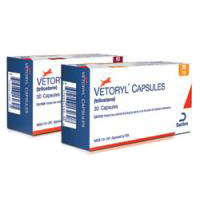Trilostane Approved by the FDA

Alternative treatment for Cushing’s disease now available in the U.S.
News item written by Mary Straus, published in the Whole Dog Journal, October 2009
In May 2009, the U.S. Food and Drug Administration (FDA) announced the approval of the drug trilostane (Vetoryl) for the treatment of hyperadrenocorticism (Cushing’s disease) in dogs.
Trilostane has been used in the U.K. since 2001, but until recently, anyone who wanted to use this drug to treat their dog in the U.S. had to fill out a lot of paperwork to get permission to import it. The FDA’s approval means the drug will now be readily available to veterinarians. There are, however, many unanswered questions about trilostane, including whether it’s safer than traditional treatment.
Cushing’s disease occurs when the body produces too much cortisol. It causes increased appetite and thirst, skin problems, muscle weakness, and panting. It can also predispose a dog to other conditions such as diabetes and pancreatitis.
There are two types of Cushing’s disease: adrenal and pituitary.
UpdateA surgical procedure used on humans to remove brain tumors that cause Cushing’s disease is now becoming available to dogs, thanks to collaboration between a human neurosurgeon, a veterinary endocrinologist, and a veterinary surgeon in the Los Angeles area. See New Treatment for Pituitary-Dependent Cushing’s Disease for more information. |
Pituitary Cushing's is the most common, accounting for 85 percent of cases. Pituitary Cushing’s is caused by a small, usually benign tumor of the pituitary gland that overproduces the hormone ACTH, which in turn tells the adrenal glands to produce excess cortisol. These tumors are usually too small to remove, so pituitary Cushing’s is managed with medications that suppress the production of cortisol.
Adrenal Cushing’s is caused by a tumor on one of the adrenal glands. It is often treated with surgery to remove the tumor.
There are three drugs that have been commonly used to treat the pituitary form of Cushing’s disease in dogs:
- Lysodren (mitotane) is the traditional therapy, though its use is off-label. This chemotherapy drug works by eroding layers of the adrenal glands. Lysodren is relative inexpensive, but careful monitoring is needed to prevent a life-threatening Addisonian crisis if cortisol levels are reduced too far. Lysodren can also cause permanent changes to the adrenals, requiring continued treatment for Addison’s disease (hypoadrenocorticism).
- Ketoconazole, an anti-fungal drug that suppresses cortisol as a side effect, is safer than Lysodren, as it does not affect the adrenal glands. It is very expensive, however, especially for large dogs, and it is not effective in 20 percent of dogs. Its use in treating Cushing’s is also off-label.
- L-deprenyl (Anipryl or selegeline) is an MAO inhibitor that acts on the pituitary gland itself. While considered very safe, it is questionable how well L-deprenyl works, particularly since it’s more difficult to measure the response with this drug, and because it can take some time to begin working. The manufacturer’s study found L-deprenyl helped more than 80 percent of dogs it followed. One independent study, however, felt that only 20 percent of treated dogs improved. L-deprenyl is the only other drug approved by the FDA for treatment of Cushing’s.
Trilostane inhibits an enzyme that is needed in the production of cortisol. As with Lysodren, this drug has the potential to cause a life-threatening Addisonian crisis if cortisol levels go too low. Initially, it was thought that trilostane would not cause permanent changes to the adrenal glands, but in a small percentage of cases, for reasons that are unknown, it’s been found to cause sometimes fatal adrenal necrosis as well as permanent Addison’s disease.
For these reasons, the same type of careful monitoring is needed as with Lysodren. Two studies found that the risk of either permanent or life-threatening Addison’s was 2 to 3 percent for trilostane, and 2 to 5 percent for Lysodren. Unlike with Lysodren, these adverse effects of trilostane do not appear to be dose-dependent, so there’s no way to predict which dogs may react. Trilostane is more expensive than Lysodren and must be given more frequently.
When switching from Lysodren to trilostane, it’s best to wait at least a month in between. Dogs who have been treated with Lysodren in the past may be more susceptible to the effects of trilostane.
Both Lysodren and trilostane can also be used to treat the adrenal form of Cushing’s, when surgery is considered too risky.
For more information:
- Dechra Veterinary Products, makers of Vetoryl
- FDA approves Vetoryl Capsules for Cushing's disease
- FDA Approves New Drug to Treat Cushing’s Disease in Dogs
- Cushing's Disease in Dogs
- Canine Cushing’s Syndrome: Diagnosis and Treatment
- Treatment: Pituitary Cushing's Syndrome
I regret that I no longer have much time to respond to questions. See my Contact page for more information. My name is Mary Straus and you can email me at either or
